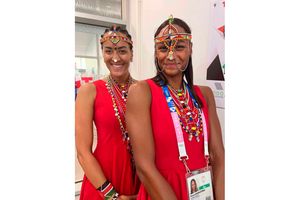
Barbushe Maina, a thespian who campaigned for Nakuru City to become a Unesco Creative City, has his mural painted on the wall of a building in Nakuru City.
Nakuru, once primarily known as the Rift Valley headquarters in Kenya, has undergone a remarkable transformation in recent years largely propelled by its vibrant arts scene.
This city with its dynamic arts scene was in November 2021 recognized as a United Nations Educational, Scientific and Cultural Organisation (Unesco) Creative City, joining 350 cities around the world that currently make up this network.
Unesco Creative Cities Network (UCCN) was created in 2004 to promote cooperation with, and among cities that have identified creativity as a strategic factor for sustainable urban development, placing creativity and cultural industries at the heart of their development plans at the local level and cooperating actively at the international level.
Nakuru's recognition as a Unesco Creative City is largely due to its flourishing arts community.
The city's artists, musicians, and performers have been instrumental in putting Nakuru on the global cultural map with their innovative and unique creations, reflecting the rich culture and history of the region, drawing the attention of both locals and international audiences.
The city's art scene is diverse and vibrant, encompassing various disciplines. From traditional crafts and contemporary visual arts to music, dance, and theater, Nakuru is a melting pot of creativity.
The recent recognition of Nakuru as the second Creative City in East Africa by Unesco, owes much of its artistic vibrancy to the efforts of Barbushe Maina, an influential figure in Nakuru's art scene.
Barbushe, commonly referred to as the 'Father of art', played a pivotal role in advocating for the town's recognition, leading to its distinction as the first Creative City in Kenya with the help of the county government as well as the Kenya National Commission for United Nations Educational, Scientific and Cultural Organisation (Unesco).
Unesco’s workshops
The journey towards positioning Nakuru as a Creative City commenced in 2008 when Barbushe initiated the painting of houses in the Flamingo and Kimathi estates.
“This conversation started in Nairobi during one of Unesco’s workshops at Kenya Institute of Education. I impressed upon them to have a look at the activities we were doing here, we had rigorous training on a different aspect and later did a 30-page questionnaire and by November we had been designated a creative city,” he said in a past interview with Nation.
With youth-led activities such as those of Barbushe, the Nakuru County Government is playing a crucial role in this cultural renaissance.
Recognizing the potential of the arts to drive economic and social development, the government has invested heavily in arts and youth programmes with initiatives designed to nurture talent, provide opportunities for creative expression, and enhance the city's cultural profile.
One of the key strategies has been the organisation of regular art festivals and cultural events. These festivals provide platforms for local artists to showcase their work, attracting visitors from all over the country and beyond.
The government has also focused on nurturing the next generation of artists through various training programs and workshops. These programs, aimed at young people, provide valuable skills in areas such as music, painting, dance, and theater. By offering training and mentorship, the government is helping to create a sustainable future for the arts in Nakuru.
Ann Okil is a prominent podcast host thanks to a county-run studio that offers locals free recording facilities.
She had a passion for storytelling while growing up in Nakuru and spent countless hours listening to radio shows and podcasts, fascinated by the way voices over the airwaves could captivate and inspire. However, like many young people in her community, Okil faced significant challenges.
Okil's podcast
With limited resources and few opportunities, her dream of becoming a broadcaster seemed far out of reach.
“I learnt about the county-run studio next to the Bondeni sub-county hospital. The studio was part of an initiative to nurture local talent and provide a platform for creative expression. The facility offered state-of-the-art recording equipment and editing software, all available for free to community members, she said in an interview.
Her first podcast episode was a modest effort and armed with little more than a basic outline and a few notes, she recorded himself discussing local news and issues that mattered to his community.
Okil's podcast has been gaining traction in the last six months and has begun to attract a diverse audience. Her episodes feature interviews with local artists, entrepreneurs, and community leaders, providing a platform for voices that were often overlooked.
Upcoming artist Eugene Solomon who goes by the stage name Hyp D says by providing free access to professional recording facilities, the studio removed financial barriers and democratized the creation of content.
“It has become a hub of creativity and innovation where locals experiment, collaborate, and express themselves,” he said.
In addition to festivals and training programs, the government has launched several community art projects. These projects aim to beautify the city and engage the community in creative activities. Public art installations, such as murals and sculptures, can be seen throughout Nakuru, turning public spaces into open-air galleries.
These community art projects have had a transformative impact on the city. They have not only made Nakuru more visually appealing but have also fostered a sense of pride and ownership among residents.
“People take pride in their city and feel more connected to their community when they see artworks that reflect their culture and history,” said Josphat Kimemia, the county’s director of Youth Affairs and Vocational training.
He explained the focus on arts and creativity has brought numerous benefits to Nakuru. Economically, the arts have become a significant driver of growth. Arts festivals and events attract tourists, creating jobs and boosting local businesses. The increased visibility of Nakuru on the cultural map has also attracted investment and support from both national and international organizations.
The arts have also provided a platform for addressing social issues and promoting dialogue. Through their work, artists can raise awareness about important issues and contribute to positive change.
“For the youth of Nakuru, the focus on the arts has opened up new opportunities. Training programs and workshops provide them with valuable skills and career prospects. The arts offer a positive outlet for expression and creativity, helping young people to build confidence and resilience,” he said.
However, some artists say the county does not treat creatives from Nakuru with the respect they deserve.
It cuts across from payment to how artists are handled in Nakuru. Barely does the pay for artists performing in events held at Nyayo Garden fetch the artist anything close to Sh10,000. As a UNESCO creative city, we need to walk the talk and not be big on words,” lamented Poet Willie Oeba.







